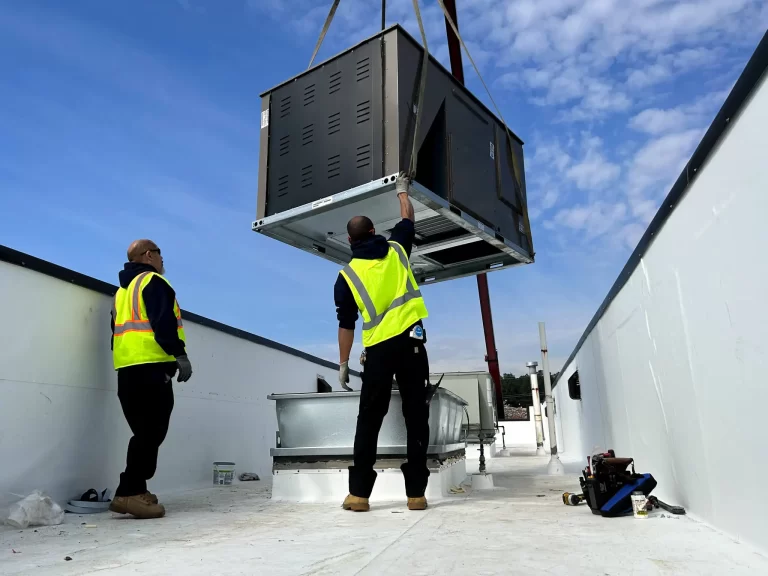In McLean, Virginia, having good indoor air quality is crucial for maintaining a healthy and comfortable home environment. The air we breathe indoors can be filled with various pollutants that can have a negative impact on our health and overall well-being. Understanding the importance of good indoor air quality and taking steps to assess and improve it is essential for every homeowner.
Understanding Indoor Air Quality
Indoor air quality refers to the quality of the air within and around buildings and structures, particularly as it relates to the health and comfort of the occupants. Poor indoor air quality can lead to a wide range of health issues, including respiratory problems, allergies, and even serious diseases.
It is important to note that indoor air can be even more polluted than outdoor air. This is because various factors, such as inadequate ventilation, the use of chemical products, and the presence of pollutants from indoor sources, can contribute to the deterioration of air quality inside buildings.
When we think about indoor air quality, we often focus on the physical aspects of the air we breathe. However, it is also important to consider the impact of indoor air quality on our mental well-being. Studies have shown that poor indoor air quality can lead to symptoms such as fatigue, irritability, and difficulty concentrating. By improving the air we breathe indoors, we can create a healthier and more comfortable environment for both our bodies and our minds.
The Importance of Good Indoor Air Quality
Good indoor air quality is crucial for our overall well-being. Breathing in clean and fresh air can improve our respiratory health, enhance our immune system, and reduce the risk of developing allergies or other respiratory conditions.
Having good indoor air quality is especially important for vulnerable populations, such as children, the elderly, and individuals with respiratory diseases. For these individuals, exposure to poor indoor air quality can have severe consequences on their health.
Imagine a child with asthma spending most of their time indoors, where the air is filled with pollutants. This child may experience frequent asthma attacks, struggle to breathe, and have difficulty participating in everyday activities. By ensuring good indoor air quality, we can create a safe and healthy environment for everyone, especially those who are most susceptible to the negative effects of poor air quality.
Common Indoor Air Pollutants
There are several common indoor air pollutants that can significantly affect the quality of the air we breathe inside our homes. These pollutants include:
- Particulate matter, such as dust, pollen, and pet dander
- Chemical pollutants, such as volatile organic compounds (VOCs) from cleaning products, furniture, and building materials
- Mold and mildew, which can grow in damp areas and release spores into the air
- Cigarette smoke and other sources of combustion pollutants
- Radon, a radioactive gas that can seep into homes from the ground
Identifying and minimizing exposure to these pollutants is essential for improving indoor air quality.
Particulate matter, one of the common indoor air pollutants, can come from various sources. Dust can accumulate from outdoor air, while pollen can enter our homes through open windows or on our clothes. Pet dander, another type of particulate matter, is often found in homes with furry companions. These tiny particles can easily become airborne and contribute to respiratory problems, especially for individuals with allergies or asthma.
Chemical pollutants, such as VOCs, can be found in many household products. Cleaning products, paints, adhesives, and even new furniture can release harmful chemicals into the air. Prolonged exposure to these chemicals can lead to headaches, dizziness, and even long-term health effects. By choosing environmentally friendly products and ensuring proper ventilation, we can reduce the levels of chemical pollutants in our indoor air.
Mold and mildew are common indoor air pollutants that thrive in damp and poorly ventilated areas. These fungi can release spores into the air, which can cause allergic reactions and respiratory issues. It is important to address any moisture problems in our homes and regularly clean and maintain areas prone to mold growth, such as bathrooms and basements.
Cigarette smoke is a well-known source of indoor air pollution. Secondhand smoke can be just as harmful as smoking itself, causing respiratory problems, lung cancer, and other serious health conditions. Implementing smoke-free policies in our homes and encouraging smokers to quit can significantly improve indoor air quality and protect the health of everyone living in the household.
Lastly, radon is a radioactive gas that can seep into homes from the ground. It is odorless and invisible, making it difficult to detect without proper testing. Prolonged exposure to high levels of radon can increase the risk of lung cancer. Testing for radon and taking necessary measures to mitigate its presence can help ensure a safer indoor environment.
By understanding and addressing these common indoor air pollutants, we can take proactive steps to improve the quality of the air we breathe and create a healthier living environment for ourselves and our loved ones.
Assessing Indoor Air Quality in McLean
Recognizing the signs of poor indoor air quality is the first step in assessing and improving the air quality in your McLean home. Here are some common signs that indicate a potential problem:
- Excessive dust accumulation
- Unpleasant odors or unusual smells
- Humidity issues, such as condensation on windows or dampness in certain areas
- Allergic reactions or respiratory symptoms that worsen indoors
Professional Air Quality Testing
If you suspect that your indoor air quality is poor, it may be beneficial to seek the assistance of a professional air quality testing service. These experts can conduct comprehensive tests to identify any potential pollutants and provide recommendations on how to improve the air quality in your home.
Professional air quality testing is particularly important if you have recently renovated your home, experienced a water leak or mold growth, or if you have concerns about specific pollutants, such as radon or asbestos.
Solutions for Improving Indoor Air Quality
Fortunately, there are several solutions available for improving indoor air quality in your McLean home. Here are a few effective methods:
Air Purifiers and Filters
Investing in high-quality air purifiers and filters can help remove airborne pollutants from your home. These devices work by capturing and trapping particles, allergens, and odors, leaving you with cleaner, fresher air to breathe.
When choosing an air purifier or filter, consider factors such as the size of your home, the type of pollutants you want to remove, and the level of filtration efficiency you desire.
Ventilation Improvements
Proper ventilation is key to maintaining good indoor air quality. It helps bring fresh air in and expel stale air and pollutants out. Improvements can include installing exhaust fans in kitchens and bathrooms, opening windows to allow for natural ventilation, or considering a mechanical ventilation system that ensures a constant supply of fresh air.
Maintaining Healthy Indoor Air Quality
Maintaining healthy indoor air quality is an ongoing process that requires regular cleaning and maintenance of your living space.
Regular Cleaning and Maintenance
Regularly cleaning your home can help reduce dust, allergens, and other pollutants, improving indoor air quality. Vacuuming carpets and rugs, dusting surfaces, and washing bedding and curtains on a routine basis can make a significant difference.
In addition to cleaning, it’s essential to keep up with regular maintenance tasks, such as changing air filters, inspecting and cleaning HVAC systems, and addressing any water leaks or moisture issues promptly.
Monitoring Indoor Air Quality
Monitoring indoor air quality is crucial for ensuring that the measures you have implemented are effective. You can use air quality monitors and sensors to measure key indicators, such as particulate matter, VOC levels, humidity, and carbon dioxide.
By regularly monitoring indoor air quality, you can identify any changes or potential issues quickly and take appropriate action to maintain a healthy environment.
The Role of HVAC Systems in Indoor Air Quality
HVAC (Heating, Ventilation, and Air Conditioning) systems play a significant role in maintaining good indoor air quality.
How HVAC Systems Affect Air Quality
HVAC systems help filter and condition the air within our homes, removing pollutants and maintaining a comfortable temperature and humidity level. However, if not properly maintained, these systems can contribute to poor indoor air quality by recirculating dust, allergens, and other pollutants.
Regular HVAC maintenance, including cleaning or replacing filters, inspecting and cleaning ductwork, and scheduling professional tune-ups, is essential for ensuring that your system operates efficiently and promotes good indoor air quality.
Choosing the Right HVAC System for Better Air Quality
When choosing an HVAC system, consider its air filtration capabilities, energy efficiency, and the potential for integrating additional air quality features, such as UV germicidal lights or electronic air cleaners. Consulting with an HVAC professional can help you select the right system for your specific indoor air quality needs.
By understanding the importance of good indoor air quality, assessing and improving it regularly, and maintaining the appropriate systems, McLean homeowners can create a healthier and more comfortable living environment for themselves and their families.


